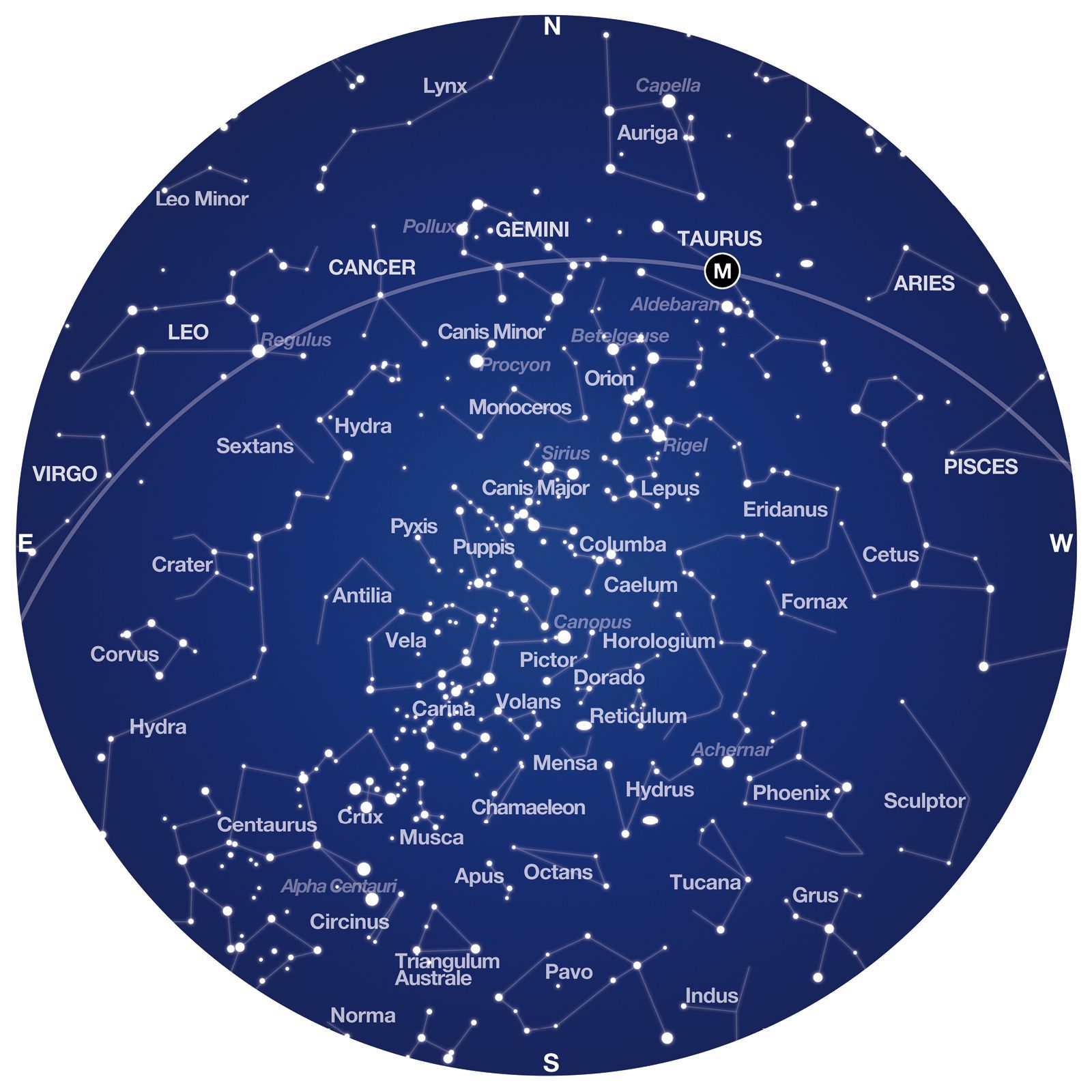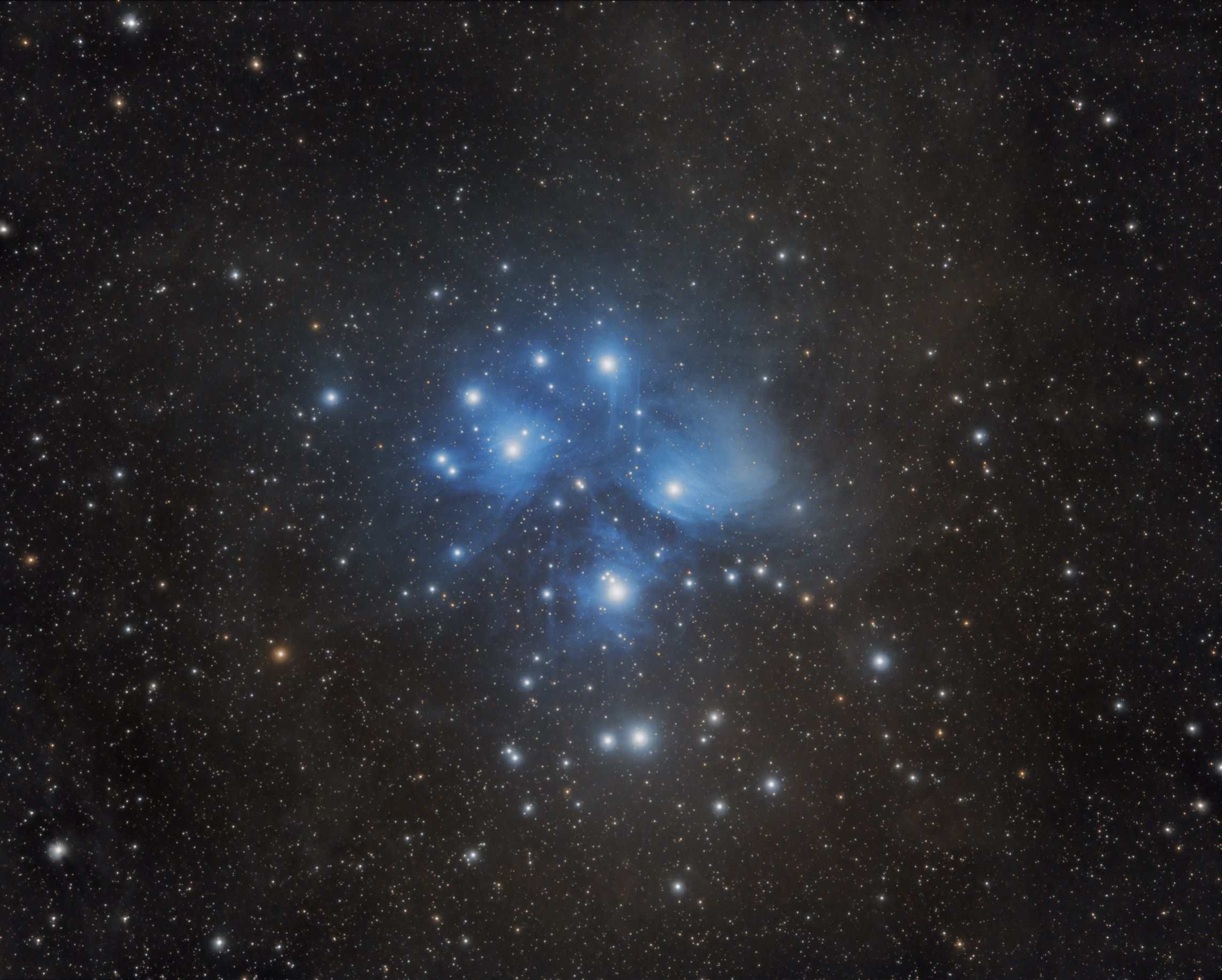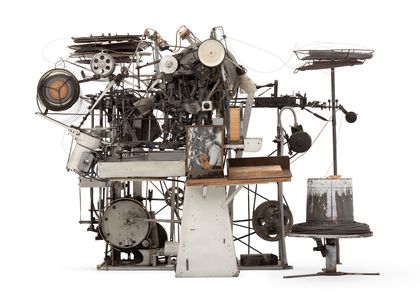
What’s in the sky this February?
Constellations
Constellations are groups of stars that form a picture. These pictures were given names and for millennia have been used as a tool for navigation and to share significant cultural stories. Astronomers use these constellations to delineate portions of the sky and as a way for locating astronomical objects. In February the following constellations dominate the spring sky:
- Orion – the hunter is high in the northern sky after sunset. Orion is easy to find, with the best-known feature of this constellation the ‘Saucepan’ asterism. This is a familiar group of stars for those of us in the southern hemisphere and is Orion’s belt and sword (Orion is upside down for us in the southern hemisphere). Below the ‘Saucepan’ you should see the red supergiant star, Betelgeuse. Betelgeuse has a distinct reddish tinge to our eye and is the shoulder of Orion. Above the ‘Saucepan’ and diagonally opposite Betelgeuse is a brilliant white star – Rigel, one of Orion’s knees. Rigel is a blue-white supergiant star which is about 60,000 times more luminous than our own Sun.
- Canis Major – the great dog is high overhead in the early evening sky. The brightest star in the constellation, Sirius, is also the brightest in the night sky. It is bright because it is close to us, only 8.7 light years away or about 82 million million kilometres from us.
- Taurus – the bull is in the northern evening sky after sunset. Follow the line of Orion’s belt to the west and you will come to the back of a sideways ‘V’ which forms Taurus’ head. One of Taurus’ eyes is an orange giant star called Aldebaran which means ‘the follower’ and it has a distinct orange tinge when viewed with the unaided eye.
- Carina – is high in the south eastern sky and represents the keel of a ship. Carina was originally part of the constellation Argo Navis (Argo was the ship of Jason and the Argonauts) and the nearby constellations of Vela (the sails) and Puppis (the stern) formed the rest of the ship. In 1756, Nicolas Louis de Lacaille published his catalogue of the southern stars showing Argo Navis divided into the three constellations we see today. Canopus, the second brightest star in the sky, can be found in Carina. It is a white supergiant star about 313 light years away.
- Vela – is high in the south eastern sky and represents the sails of the former constellation Argo Navis. During the division of Argo Navis, the stars in Vela were not given new Greek letter designations so Vela has no alpha or beta stars, instead Gamma Velorum is the brightest star in this constellation.
Planets
Jupiter is the only planet in the evening sky while Mercury, Venus, Mars and Saturn are in the early morning sky this month.
- Mars – is visible in the northern sky as soon as the sun sets at the start of the month (north-west by the end of the month). The waxing gibbous Moon will be close in the sky on the 1st, and again on the 28th of the month
- Jupiter – gas giant Jupiter will be low in the western sky in the constellation of Pisces after sunset for the first week or so of February but disappears into twilight by the middle of the month.
- Venus – can be seen in the western sky right around sunset for the duration of the month. Visibility will improve as the month progresses and the Sun sets earlier and earlier. The planet starts the month in Aquarius and ends the month in Pisces. On the 23rd, Venus, Jupiter and the thin waxing crescent Moon will all be in a line in the sky.
- Mercury – is visible in the pre-dawn sky for the duration of the month. The best visibility will be the beginning of the month when it rises the earliest. Mercury begins the month in the constellation of Sagittarius and moves into Capricornus by the middle of the month.
- Saturn – you may just catch a peek of Saturn on the final day or two of the month, when it joins Mercury in the pre-dawn sky, but March will bring better viewing for the ringed planet.
Moon
- Full Moon is on Monday 6th February at 5:28am
- Last Quarter is on Tuesday 14th February at 3:01am
- New Moon is on Monday 20th February at 6:06pm
- First Quarter is on Monday 27th February at 7:06pm
Deep Sky
Explore the universe through binoculars or a telescope and take in these gems of the February sky:
- Orion Nebula (M42) – one of late summer’s most magnificent sites and is the middle point of light in the handle of the ‘Saucepan’ in the constellation of Orion. While visible to the unaided eye, observers using binoculars or a telescope can follow the swirls and loops of gas and dust in this active stellar nursery. The Orion Nebula is part of the Orion Molecular Cloud, an immense star forming region hundreds of light years across. The Orion Nebula is approximately 40 light years in diameter and lies about 1,500 light years away.
- Pleiades (M45) – an open star cluster that can be seen with your eyes to the north-west of the ’V’ of Taurus. The Pleiades are known as the ‘Seven Sisters’ as seven stars are readily seen with your eyes, but away from city lights, up to thirteen can be seen with the unaided eye. Binoculars are the best way to view this wonderful object. The Pleiades are approximately 443 light years away.
- Tarantula Nebula (NGC 2070) – a large hydrogen gas cloud approximately 1,000 light years in diameter in the Large Magellanic Cloud (LMC). The name ‘Tarantula’ comes from the spider-like appearance of the nebula in telescopes and photographs. At the centre of the nebula is the open cluster R136, which contains approximately 500,000 stars that are some of the hottest and most massive supergiant stars we know of.
- Carina Nebula (NGC 3372) – visible to the unaided eye and spanning more than 300 light years, this nebula is one of the largest and brightest star forming regions in our sky. Within the Carina Nebula is the star Eta Carinae, a binary system that is one of the most energetic in the region. Next to Eta Carinae is the Keyhole Nebula (NGC 3324), a molecular cloud of gas and dust and an active star forming region that looks, as the name suggests, like an old fashioned key hole. The Carina Nebula is about 7,500 light years away.
- Crab Nebula (M1) –is the remnant of a star that ended its life as a supernova visible from Earth on July 4, 1054AD. It was observed by Chinese astronomers and also recorded in Native American petroglyphs. At the centre of this remnant is a pulsar which currently emits at a rate of 30 pulses per second though this rate will slow to half of this over the next 1,000 years. The Crab Nebula lies about 6,500 light years away.
- M41 (NGC 2287) – is a bright open star cluster in Canis Major. M41 contains approximately 100 stars and there is some debate over their age with estimations ranging from 190 million to 240 million years old. The cluster is about 2,300 light years away.

Other events in February 2023
This month, on February 15, we mark the 10th anniversary of the Chelyabinsk meteor impact. A small asteroid, almost 20 metres in diameter, crashed to Earth in Siberia. It shattered windows (injuring many who had looked out to see what the bright light was), damaged many buildings and was captured on dash-cams across the region. Such impacts are expected to occur about once every few decades.
This month’s Southern Sky Guide was prepared by Melissa Hulbert and Dr Sarah Reeves.
Learn More
- Purchase the 2023 Australasian Sky Guide by Dr Nick Lomb, featuring an annual report of what’s in the sky and the latest astronomical findings. Produced by MAAS Media.
- View the Star Map 02 February 2023, which shows the stars, constellations and planets visible in the night sky from anywhere in Australia
- Check out these resources for getting started.



where is the green comet?
mwal, its currently in the constellation Camelopardalis (at Feb 02 2023). Its not visible from most of Australia yet. Please see our post on this comet.